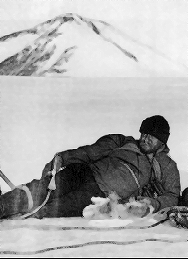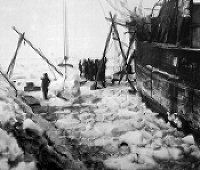![]()
|
|
|
|
|
|||
The crew
amounted to only 32 men. Of the 32, there were 22 regular
crew members, 5 naval officers and 5 scientists (including
himself). On
August 11, 1901, the Gauss left Kiel for the south.
On January 2, 1902, they reached Îles Kerguelen. On
January 31 the Gauss left Kerguelen for the
Antarctic and seven days later they sighted the first of
many icebergs. Navigation was particularly difficult from
this point on and it wasn't until February 21 that the first
land was sighted. Drygalski wrote the "coherent, uniform
white contours, and in one place in the north-east darker
spots which, when coming closer, also turned out to be ice.
But there was no question about it: all the ice was on solid
land...everywhere it ended abruptly at the water's edge,
forming cliffs 40 to 50 meters high...the area behind them
rose gently to about 300 meters..." Here, about 90°
longitude, Kaiser Wilhelm II Land was named. It was late
afternoon on February 21 that the ship attempted to enter an
opening between two ice ridges only to become
trapped. Drygalski and
his men were to encounter many of the hardships of the
Antarctic winter, just as Carsten
Borchgrevink and the crew of
the Belgica before them. Fortunately, the ship was
adequately supplied and the cabins / mess rooms were very
comfortable. One of the crewmembers, F. Bidlingmaier, best
described off-duty hours on the Gauss as follows:
"Sundays were beer-nights, Wednesdays were lecture-nights,
but Saturday nights were best of all: on them we sat
together behind a glass of grog, united in games or
conversation. Clubs sprouted like mushrooms. There were
several card-clubs, a gentleman's cigar-smoking-club,
glee-clubs, a band composed of a harmonica, flute, triangle
and two pot-lids for a cymbal". Although
somewhat pleasant indoors, outdoors was another matter.
Snowstorms raged and other than her masts, the ship nearly
disappeared in the snow. Temperatures dropped to -18°F
resulting in cracked instruments and dozens of broken
bottles of German beer! On the other hand, there were
occasional good days and it was during these times that
scientific data was collected. The men built a windmill to
generate electricity while others went on hunting
expeditions for seal and penguin: "Their hearts and livers
made a most delicious ragout...we loved it better than our
tinned food". "By
March the situation had stabilized so much that I thought it
was time to start the sledging expeditions". The first
expedition left on March 18th, lasting eight days, and
resulted in the first physical proof of reaching the
Antarctic mainland when crewmembers returned with pieces of
volcanic rock. The discovery, about 50 miles from the ship,
was named Gaussberg. (See top photo). Drygalski
became the first balloonist in Antarctica when he climbed
aboard the balloon the Gauss was carrying and rose
to an altitude of 1600 feet. "It was so warm up there I
could even take off my gloves...the sight from this altitude
was grandiose. I could see newly discovered Gaussberg
and...gave my description via telephone to the deck of the
ship. It was the only ice-free landmark in the surrounding
area". In early
April, a second sledging expedition returned from a 13-day
trip to Gaussberg where the four men had built a temporary
shelter for any further trips to this area. It was at this
time that Drygalski decided to take part in a third
expedition which was very nearly his last. Temperatures had
dropped to -38°F by the time the men had reached
Gaussberg on April 27, six days after leaving the ship.
Unfortunately, upon their arrival they discovered the
shelter in ruins from the previous storms. Many hours were
spent rebuilding the shelter. The next few days were devoted
to geological and magnetic surveys. On their way back to the
ship another storm hit. Food quickly ran out and just as
they prepared themselves to kill some of the dogs, they
stumbled upon a dead seal that had been killed by the
previous teams. They now had plenty of food but the weather
was so poor they totally lost their bearings. However, good
fortune followed them as they literally stumbled into the
snow-covered Gauss again. Gaussberg,
located at 66°40'S, was the southern limit of the
expedition. Drygalski thought it possible to attain 72°
or 73°S but abandoned the idea when spring arrived. As
spring arrived, attention was now given to the purpose of
freeing the ship from the ice. The ice had started to break
up but they were still 2000 feet from the nearest stretch of
open water. Holes were dug through the ice by hand and
filled with explosives in an attempt to blast their way
free. Steel saws, some 20 feet long, were used to cut
through the ice beside the ship's hull but progress was
very, very slow. The crew was beginning to wonder if a
second ship would be sent from Germany to search for them.
Hans Ruser, captain of the Gauss, went so far as to
suggest throwing empty beer bottles into the water with
messages contained inside with a description of their
position. Furthermore, he suggested 100 more bottles be
dropped by the balloon when a next northerly wind came up.
One day Drygalski was walking around the ship when he
noticed an area where soot from the ship's funnel had landed
and melted the ice beneath. He determined that the black
color of the soot absorbed the light from the sun which then
melted the ice beneath. Immediately he ordered garbage
aboard the Gauss be laid in a trail to the open
water. "Success came immediately. The ice under the dirt
started to melt. Within a month we had a long water channel
almost two metres deep. Although there were still four to
five metres of ice underneath, the channel widened
constantly" which grew into a small pond. By the end of
December, 1902, rain fell. Christmas
and New Year's Day passed and it was not until February 8,
1903 that "we suddenly felt two sharp jolts in rapid
succession...it was like a revelation, and with a cry 'the
ice is breaking', I jumped out on to the deck". With the
ship free from the ice, the expedition started a slow voyage
along the Antarctic coast. Travelling among the floes was
dangerous and slow so on March 31 Drygalski ordered retreat.
"It was a most difficult decision, certainly the most
difficult one I had to make, but it was necessary. There was
no safe place to spend the winter here..." They reached the
tip of South Africa on June 9 where Drygalski sent a request
to Berlin suggesting another wintering in the Antarctic. On
July 2 his request was denied, probably due to the fact that
the Kaiser was disappointed that no new territory of
significance had been discovered. The Gauss arrived
in Kiel on November 23, 1903. Regardless,
Drygalski wrote "...we found new territory in the Antarctic
itself...something we can look back to in full
satisfaction". Drygalski spent many years documenting his
expedition as he published 20 volumes between 1905 and 1931.
In 1906 he became Professor of Geography at Munich and in
1910 took part in Count Zeppelin's expedition to
Spitsbergen. He retired from the university in
1934.
 Erich von
Drygalski was born on February 9, 1865 in Köningsberg,
East Prussia. Near the end of the nineteenth century
'Antarctic fever' broke out in western Europe and in 1898
the German South Polar Commission suggested a national
expedition to Antarctica. As Professor of Geography and
Geophysics at the University of Berlin, Drygalski was
certainly qualified and was subsequently chosen to be the
leader of the expedition. Financing was not an issue but the
Commission felt one ship would be all that was necessary so
Drygalski asked for and received permission to build a new
vessel rather than modify an existing ship.
Erich von
Drygalski was born on February 9, 1865 in Köningsberg,
East Prussia. Near the end of the nineteenth century
'Antarctic fever' broke out in western Europe and in 1898
the German South Polar Commission suggested a national
expedition to Antarctica. As Professor of Geography and
Geophysics at the University of Berlin, Drygalski was
certainly qualified and was subsequently chosen to be the
leader of the expedition. Financing was not an issue but the
Commission felt one ship would be all that was necessary so
Drygalski asked for and received permission to build a new
vessel rather than modify an existing ship. "Later, nobody recalled exactly what happened during
the next hours but we all felt that we had become a toy of
the elements. A snowstorm blew up, floes and 'bergs closed
in..." For the next few days the men tried everything to
work the ship free of the ice but to no avail. By March 2
"our fate had been sealed: the trap we had entered had
closed".
"Later, nobody recalled exactly what happened during
the next hours but we all felt that we had become a toy of
the elements. A snowstorm blew up, floes and 'bergs closed
in..." For the next few days the men tried everything to
work the ship free of the ice but to no avail. By March 2
"our fate had been sealed: the trap we had entered had
closed".